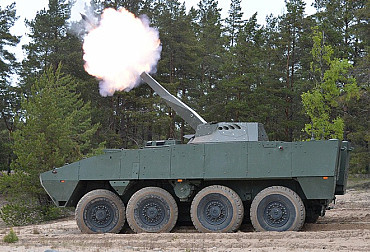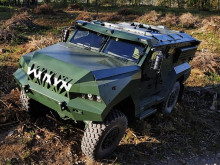Polish Project of Tank Destroyers: To What Extent Would a Similar Project Be Usable Within the ACR
There was a new project launched in Poland last summer, called Ottokar Brzoza. This is a project of “tank destroyers” for the Polish army. These are vehicles that are capable of firing anti-tank guided missiles. Due to the variability of Polish vehicles, there are various offers at hand. It is also worth considering whether a similar project could be used within the ACR.
Polish project
As part of the extensive modernization of the Polish ground forces, the modernization and rearmament is being prepared of units that still have Soviet BRDM-2 vehicles equipped with Maljutka anti-tank missiles. The Polish army plans to deploy new tank destroyers on the Polish-Lithuanian border (known in English as Suwalki Gap), an area where a major conflict will take place in the event of an open conflict with Russia. As is well known, Russia still relies on the strength of its strike tank units – for example, the 1st Guards Tank Army was recently reactivated in the Western Military District. The new tank destroyer of the Ottokar Brzoza project is intended against Russian tank units. Both tracked and wheeled platforms have a chance. The tender has attracted both Polish and renowned foreign companies such as MBDA, Lockheed Martin or Rheinmetall.
In this article, we will focus on two specific variants – the offer of MBDA and the offer of Rafael, or the Polish PGZ. The first mentioned offer, made by MBDA, includes three possible variants of the Brimstone multi-purpose missile carrier – the Zubr wheeled armoured vehicle, the Rosomak wheeled combat vehicle (the Polish variant of the Patria vehicle) and the BVP-1 tracked infantry fighting vehicle. The Brimstone missile is guided by radar or a semi-active laser. The range of the projectile is more than 12 km. The competitive advantage of the Brimstone variant is the fact that Polish companies are already producing components for this missile and Mesko is part of the global supply chain MBDA.

Picture: The MBDA’s offer includes three possible variants of the Brimstone multi-purpose missile carrier – the Zubr wheeled armoured vehicle, the Rosomak wheeled combat vehicle (the Polish Patria variant) and the BVP-1 tracked infantry fighting vehicle. | archive of MBDA / CC BY NC-ND
The second mentioned offer, of the Israeli company Rafael in cooperation with the Polish state arms factory PGZ, includes variants for the wheeled combat vehicle Rosomak and the tracked infantry fighting vehicle BVP-1. In the future, the launcher can be placed on the Polish Borsuk platform. Rafael’s tank destroyer is armed with an anti-tank guided missile SPIKE NLOS (Non-Line of Sight), which has a range of up to 32 km and is capable of passive guidance – without any radiation from radio or laser beams. Although it is an Israeli anti-tank missile, it is fully compatible with NATO standards, as evidenced by the high number of NATO countries which use various variants of this missile (including the Czech Republic). Proof of the European interest in the SPIKE missile is also the establishment of the company Eurospike, whose ownership structure includes Rheinmetall. In addition to the Ottokar Brzoza project, the company Rafael with the SPIKE missile is also applying for the KRUK project – the acquisition of new attack helicopters for the Polish army.

Picture: The offer of the Israeli company Rafael in cooperation with the Polish state arms factory PGZ includes variants for the wheeled combat vehicle Rosomak (pictured in the foreground) and the tracked infantry fighting vehicle BVP-1 (in the background). | archive of Rafael / CC BY NC-ND
Czech options
Just like Poland, the Czech Republic is undergoing extensive modernization of the army. The ACR plans to modernize and supplement the vast majority of units. The main conceptual documents that describe the future structure and equipment of the ACR are the so-called Construction Concept of the ACR 2025 and 2030. According to the Construction Concept 2025, the ability of light motorized battalions to destroy armoured targets will be strengthened. According to the Construction Concept 2030, the 44th Light Motorized Battalion will be reorganized into a mechanized battalion. Given that it is part of the 4th Rapid Deployment Brigade, we can assume that the future mechanized battalion will be armed with a wheeled IFV Pandur II. Due to the intention according to Construction Concept 2025, it is possible to consider the introduction of a similar concept of a tank destroyer as in Poland. This solution suitably complements and expands the firepower of units of the 4th Rapid Deployment Brigade not only against enemy armoured targets, but also cars and strongholds.
This solution will find application both in the conventional conflict that Poland is preparing for in the area of the Polish-Lithuanian border and in an asymmetric conflict, such as the conflict in Mali. The wheeled IFV Pandur II variant is not the only possible option for expanding the ACR’s firepower using anti-tank guided missiles. As already mentioned, MBDA offered the possibility of placing Brimstone missiles on the Zubr wheeled platform. The ACR is armed with the Iveco LOV, the licensed copy of which is used by the Russian army, which has placed eight Kornet anti-tank missiles on this vehicle. In the case of the use of both variants, there will be a significant expansion of firepower within the units using LOV Iveco and Pandur II vehicles. Due to their relatively low weight and easy transportability using C-130 aircraft, it will be possible to deploy them quickly wherever needed.
However, the expansion of firepower is not the only advantage offered by the project of a new tank destroyer. As is well known, the Pandur vehicle is manufactured completely in the Czech Republic. In the case of the Iveco LOV, it is only a partial production. The introduction of such a platform would thus support the Czech defence and security industry. As for the missiles used, no candidate can be eliminated in advance, but given the fact that Israeli SPIKE missiles are already introduced in the ACR, it would be logical to introduce these missiles. In this area, it may also be a matter of supporting domestic industry, albeit indirectly. As already mentioned, Eurospike is partly owned by Rheinmetall, which recently made an agreement with the Czech holding CSG. No matter how the ACR would introduce a tank destroyer, it would be an acquisition that would suitably support the Czech industry and at the same time supply the army with state-of-the-art technology.





















